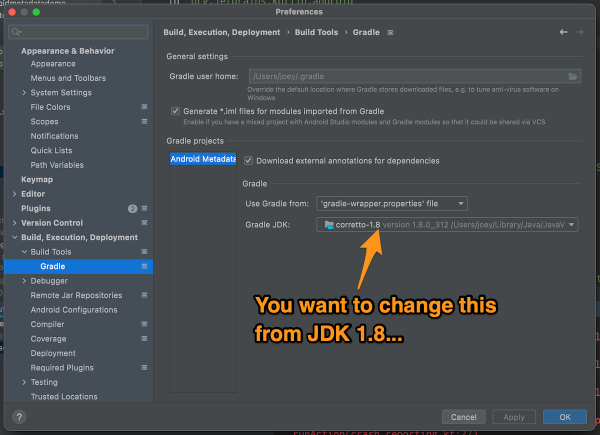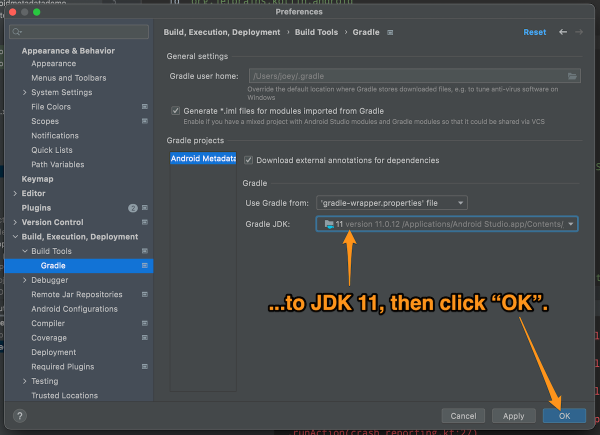


Maybe you’ve run into this Android Studio problem lately. You’ve created a brand new project, and when you run it — even if you haven’t made any changes — you get the dreaded Android Gradle plugin requires Java 11 to run error:

Here’s the “quick and dirty” fix. It assumes that you already have JDK 11 installed.
Once the Settings or Preferences window is open, select Build, Execution, Deployment → Build Tools → Gradle from the menu on the left side.
You can change the JDK that Gradle uses in the Gradle projects section’s Gradle JDK menu. Changing the current selection from JDK 1.8 to JDK 11 works for me:


The Android Studio on my Windows machine already defaults Gradle to JDK 11, but on my Mac, it’s still insisting on JDK 1.8. I’m sure there’s some config file floating around somewhere that I need to edit — does anyone know which one? — but in the meantime, I’m using the quick and dirty fix.
Yesterday was Evening 3 of the 10-evening “Learn Python” class that I’m teaching on behalf of Computer Coach, a tech training center here in Tampa. It started last Wednesday and takes place online every Monday and Wednesday from 6:00 p.m. to 10:00 p.m.. There are 15 students in the class.
So far, the class is going well. In fact, I’m rather impressed. Even though some of them have only a little programming experience and others have none, they’re learning at a great pace, and better still, they’re cleverly applying what they’re learning, and they’re not afraid to ask questions and experiment.
For example, there’s the Fizzbuzz exercise. It’s where the challenge is to a program that counts from 1 to 100 and prints out the current number as it does this, while following these rules:
Not only did they figure out how to make it work — not bad for evening 2! — but some of them started add their own ideas to the application. One said “I’m tweaking the program so that you can enter what numbers get turned into ‘fizz’ and ‘buzz’ instead of just 3 and 5.” And those modifications worked.
While covering if for comparing numbers, another student asked “Is there some way where I can compare a number to see if it’s part of a group of different numbers?” This led me to introduce lists and the in operator a little early, but it was a sign that one of them was already trying to come up with ways to apply a concept they’d just learned minutes before.
Last night, while I was demonstrating some list methods, yet another student asked “How do I pop an item from one list and then add it to another?” Again, that’s something someone does only when they grasp a new concept and start thinking up applications for it.
I just have to say this: I’m very impressed with this Python class.

Here’s a quick summary of the course:
You’ll need the following to participate in the course:

All you have to do is look at the current developer surveys and tech news headlines to know that right now, Python is having its “moment”:

CodingNomads, a coding school in California, looked at thousands of job postings in North America and Europe and declared Python as the most in-demand coding language for 2022.
As for salaries…

…you can say that the pay is decent. Pair Python with another tech skill (for instance, JavaScript) or a people skill (say, managing developers), and you can make even more.
This is the course schedule for Learn Python. It’s flexible — if there’s a need spend more time on a specific topic, we’ll do that. The point isn’t to cover every topic on the list; it’s to give you the necessary grounding in Python and programming to continue after the course is over!
Sessions will take place via Zoom, which means that you can take the course from wherever you happen to be. There will be ten sessions, and each will run from 6:00 p.m. to 10:00 p.m., with ten-minute breaks at the end of the first, second, and third hour.

This is not a passive course! This isn’t the kind of course where the instructor lectures over slides while you take notes (or pretend to take notes while surfing the web or checking your social media feeds). In this course, you’ll follow along as I write code on my screen. You’ll actively take part in the learning process, entering code, experimenting, making mistakes, correcting those mistakes, and producing working applications. You will learn by doing. At the end of each session, you’ll have a collection of little Python programs that you wrote, and which you can use as the basis for your own work.
The course will start at the most basic level by walking you through the process of downloading and installing the necessary tools to start Python programming. From there, you’ll learn the building blocks of the Python programming language:
Better still, you’ll learn how to think like a programmer. You’ll learn how to look at a goal and learn how you could write a program to meet it, and how that program could be improved or enhanced. You’ll learn skills that will serve you well as you take up other programming languages, and even learn a little bit about the inner workings of computers, operating systems, and the internet.
We’ll build as many applications as we can, based on your suggestions or needs. These include (and aren’t limited to):
Once again, you’ll want to contact Computer Coach’s Kasandra Perez at Contact Kasandra Perez at kasandra@computercoach.com or (813)-254-6459 to find out more about the course or register.

ng-conf 2022, the annual conference dedicated to all things Angular, gets into full swing tomorrow and continues on Thursday and Friday! I’m in Salt Lake City to take care of the Auth0 booth — if you’re there, please drop by!
Hopefully, you’ve made plans to see my coworkers’ talks: Alisa Duncan’s There’s Safety in Angular, which is scheduled for Wednesday, August 31 at 10:32 a.m. MDT, and then RXWut? and scheduled for Wednesday, August 31 at 2:36 p.m. MDT, presented by my coworker Sam Julien and Cloudinary’s Kim Maida.
But have you planned out how you’re going to work the room?
It’s been my experience that some of the most important things I’ve learned and all the connections I’ve made at conferences didn’t happen at the presentations. Instead, they happened between presentations — in the hallways, lounges, lunches, and social gatherings, where I had the chance to chat with the speakers, organizers, and the other attendees. This observation is so common that it’s given rise to “unconferences” like BarCamp, whose purpose is to invert the order of things so that the conference is more “hallway” than “lecture theatre”.
It’s especially important to talk to people you don’t know or who are outside your usual circle. Books like The Tipping Point classify acquaintances with such people as “weak ties”. Don’t let the word “weak” make you think they’re unimportant. As people outside your usual circle, they have access to a lot of information, people, and opportunities that you don’t. That’s why most people get jobs through someone they know, and of those cases, most of the references came from a weak tie. The sorts of opportunities that come about because of this sort of relationship led sociologist Mark Granovetter to coin the phrase “the strength of weak ties”.
The best way to make weak ties at a conference is to work the room. If the phrase sounds like sleazy marketing-speak and fills your head with images of popped collars and wearing too much body spray, relax. Working the room means being an active participant in a social event and contributing to it so that it’s better for both you and everyone else. Think of it as good social citizenship.
If you’re unsure of how to work the room, I’ve got some tips that you might find handy…

A one-line self-introduction is simply a single-sentence way of introducing yourself to people you meet at a conference. It’s more than likely that you won’t know more than a handful of attendees and introducing yourself over and over again, during the conference, as well as its post-session party events. It’s a trick that Susan RoAne, room-working expert and author of How to Work a Room: The Ultimate Guide to Making Lasting Connections In-Person and Online teaches, and it works. It’s pretty simple:
My intro will be something along the lines of “I’m a rock and roll accordion player, but in my side gig, I’m a developer advocate for an incredibly cool company that helps make logins happen.”
At ng-conf, you’ll probably see a group of people already engaged in a conversation. If this is your nightmare…
…here’s how you handle it:
Feel free to join me in at any conversational circle I’m in! I always keep an eye on the periphery for people who want to join in, and I’ll invite them.

Here’s more advice on how to work the room:
I’ll see you at ng-conf, whether at the Auth0 booth, or just wandering around. Please say “hi” — we would love to meet you!

One of the more ridiculous aspects of the S-1 Form that WeWork filed during their first attempt at an IPO was the fact that the name “Adam” (WeWork’s founder / personality behind the cult Adam Neumann) gets mentioned in it a ludicrous number of times. It’s not unusual for an S-1 Form to mention the founder’s name a couple dozen times, but nowhere near as many times as WeWork’s original S-1 did.
You could go through WeWork’s S-1 and count the number of times “Adam” appears in its text. You could load WeWork’s S-1 into a text editor and have it give you that number. But what if you had to do that for a dozen, or a hundred, or a thousand companies and create a list of the number of times each company’s founder was mentioned in its S-1? You will write a Python script to do just that in my upcoming course.
I’ll guide you through the process of writing that script and running it on not just the text of WeWork’s S-1, but also for other hot tech companies, such as Zoom, Uber, Lyft, and Slack.
It’s just one of the practical things I’ll cover in the Learn Python online course being offered by Computer Coach. Here are the quick details:

For more details, see this post: I’m teaching another 5-week / 10-evening Python course starting September 7th!

Tampa Code Camp is back! Tampa Bay’s annual (at least until the pandemic) FREE coding conference returns to Keiser University’s Tampa campus on Saturday, October 8 for a full day of coding and tech sessions. And that means they need speakers, and you could be one of them!
Tampa Code Camp’s sessions have these levels…
…and fall into these categories:
The call for speakers closes on September 30, but that’s no excuse to procrastinate. If you’ve got an idea for a talk, submit it at the Tampa Code Camp call for speakers page!
For more details, or to let them know that you’ll be attending, visit the Tampa Code Camp 2022 Meetup page.